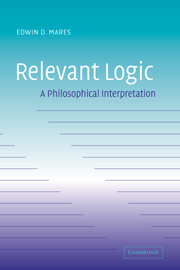Book contents
- Frontmatter
- Contents
- Preface
- Acknowledgements
- I Relevant logic and its semantics
- II Conditionals
- III Inference and its applications
- 9 The structure of deduction
- 10 Disjunctive syllogism
- 11 Putting relevant logic to work
- 12 Afterword
- Appendix A The logic R
- Appendix B Routley–Meyer semantics for R
- Glossary
- References
- Index
11 - Putting relevant logic to work
Published online by Cambridge University Press: 03 September 2009
- Frontmatter
- Contents
- Preface
- Acknowledgements
- I Relevant logic and its semantics
- II Conditionals
- III Inference and its applications
- 9 The structure of deduction
- 10 Disjunctive syllogism
- 11 Putting relevant logic to work
- 12 Afterword
- Appendix A The logic R
- Appendix B Routley–Meyer semantics for R
- Glossary
- References
- Index
Summary
Doing things with logic
We have already discussed various jobs that relevant logic can do. It provides us with a theory of situated inference, a theory of implication, and the basis of a theory of conditionals. In this chapter we will use those theories to do other work that is of interest to philosophers, mathematicians and computer scientists.
Dyadic deontic logic
In chapter 6 above, we briefly discussed deontic logic. There we discussed the operator, ‘it ought to be that’. There are also logics that contain a dyadic deontic operator, ‘it ought to be that … on the condition that’. This is usually written in formal notation as ‘O(_/_)’. The formula, ‘O(B/A)’ is read ‘It ought to be that B on the condition that A’. In this section, I will argue that the dyadic deontic operator should be taken to be some sort of relevant counterfactual.
The link between counterfactual conditionals and dyadic deontic operators is quite striking. Like a counterfactual, the connection in a dyadic deontic statement between antecedent and consequence is defeasible. For instance, suppose that my friend Kevin asks to borrow a length of rope from me. I know that, on the condition that Kevin is a friend and that he asks to borrow a rope, I should lend it to him. But suppose that I then discover good evidence that Kevin is extremely depressed, so much so that I fear that he is suicidal. Then my obligation to lend Kevin the rope is annulled, since I fear that he may hang himself with it.
Information
- Type
- Chapter
- Information
- Relevant LogicA Philosophical Interpretation, pp. 189 - 206Publisher: Cambridge University PressPrint publication year: 2004
